Continuously Variable Transmission (CVT)
WARNING:
- Do not depress the accelerator pedal while shifting from P (Park) or N (Neutral) to R (Reverse), D (Drive), Ds (Drive Sport) or (M) Manual shift mode. Always depress the brake pedal until shifting is completed. Failure to do so could cause you to lose control and have an accident.
- Cold engine idle speed is high, so use caution when shifting into a forward or reverse gear before the engine has warmed up.
- Do not downshift abruptly on slippery roads. This may cause a loss of control.
- Never shift to P (Park) or R (Reverse) while the vehicle is moving. This could cause an accident.
CAUTION:
When stopping the vehicle on an uphill grade, do not hold the vehicle by depressing the accelerator pedal. The foot brake should be used for this purpose.
The CVT in your vehicle is electronically controlled to produce maximum power and smooth operation.
The CVT can operate in two different automatic drive modes:
- D (Drive) mode - Move the shift selector to D (Drive), the transmission is in the normal forward automatic driving mode. The position indicator in the meter shows a D. The D (Drive) mode does not produce a gear change sensation like a traditional automatic transmission.
- Ds (Drive Sport) mode - Move the shift selector over from D (Drive) to the left into the manual shift gate. The position indicator in the meter shows a Ds. In Ds (Drive Sport) mode, transmission operation changes to 9Sporty driving shift operation, creating a more aggressive acceleration feeling than the D (Drive) mode and a gear change sensation when the driver accelerates quickly.
When the driver selects M (Manual) mode ratio with shift selector or shift paddles (if so equipped) during Ds (Drive Sport) mode operation, the driver must move the shift selector from Ds mode to D mode and back again to re-select Ds (Drive Sport) mode.
- To cancel the Ds mode, return the shift selector to the D (Drive) position. The transmission returns to the automatic drive mode.
The CVT can operate in two manual drive modes:
- M (Manual) mode - With the shift selector in the manual shift gate Ds (Drive Sport) mode, M (Manual) mode can be selected by moving the shift selector up (+) or down () or using the shift paddles (if so equipped) up (+) or down (). InMmode, the transmission will produce noticeable upshifts and downshifts.
The position indicator in the meter shows a M.
- Temporary M (Manual) shift mode - With the shift selector in the D (Drive) mode and if the shift paddle is moved + (up) or - (down), the transmission will temporarily switch to the M (Manual) mode. If the shift paddles are not used after 5 - 10 seconds, the transmission will return to the D (Drive) mode.
- To cancel theM(Manual) mode and return to the D (Drive) mode, press and hold either shift paddle for 3 - 5 seconds.
Follow these procedures for maximum vehicle performance and driving enjoyment.
NOTE:
Engine power may be automatically reduced to protect the CVT if the engine speed increases quickly when driving on slippery roads or while being tested on some dynamometers.
Starting the vehicle
1. After starting the engine, fully depress the foot brake pedal before moving the shift selector out of the P (Park) position.
2. Keep the foot brake pedal depressed and move the shift selector into a driving gear.
3. Release the foot brake, then gradually start the vehicle in motion.
4. Stop the vehicle completely before shifting the shift selector to the P (Park) position.
The CVT is designed so the foot brake pedal MUST be depressed before shifting from P (Park) to any drive position while the ignition switch is in the ON position.
The shift selector cannot be moved out of P (Park) and into any of the other gear positions if the ignition switch is pushed to the LOCK or ACC position.
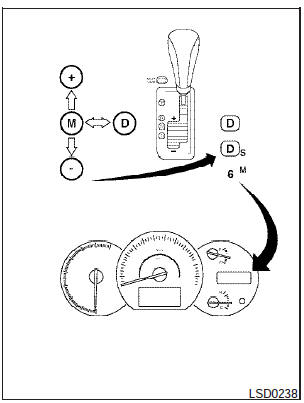
To move the shift selector:
 Push the button while
depressing the brake
pedal
Push the button while
depressing the brake
pedal
 Push the button to shift
Push the button to shift
 Shift without pushing button
Shift without pushing button
Shifting
After starting the engine, fully depress the brake pedal and move the shift selector from P (Park) to any of the desired shift positions.
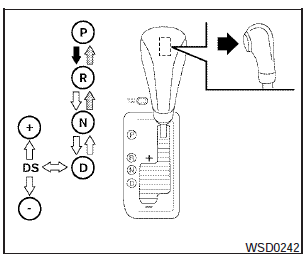
WARNING:
Apply the parking brake if the shift selector is in any position while the engine is not running. Failure to do so could cause the vehicle to move unexpectedly or roll away and result in serious personal injury or property damage.
P (Park):
CAUTION:
To prevent transmission damage, use the P (Park) or R (Reverse) position only when the vehicle is completely stopped.
Use the P (Park) shift selector position when the vehicle is parked or when starting the engine.
Make sure the vehicle is completely stopped.
The brake pedal should be depressed to move the shift selector from N (Neutral) or any drive position to P (Park). Apply the parking brake. When parking on a hill, apply the parking brake first, then move the shift selector into the P (Park) position.
R (Reverse):
CAUTION:
To prevent transmission damage, use the P (Park) or R (Reverse) position only when the vehicle is completely stopped.
Use the R (Reverse) position to back up. Make sure the vehicle is completely stopped before selecting the R (Reverse) position. The brake pedal must be depressed to move the shift selector from P (Park), N (Neutral) or any drive position to R (Reverse).
N (Neutral): Neither forward nor reverse gear is engaged. The engine can be started in this position. You may shift to N (Neutral) and restart a stalled engine while the vehicle is moving.
D (Drive): Use this position for all normal forward driving.
Ds (Drive sport): When the selector lever is shifted from the D (Drive) position to the manual shift gate, the transmission enters the Ds (Drive Sport) mode.
Moving the shift selector to the DS (Drive Sport) position allows smooth acceleration or deceleration on a hilly road by moving in a lower gear automatically. When canceling the Ds mode, return the shift selector to the D (Drive) position.
The transmission returns to the normal driving mode.
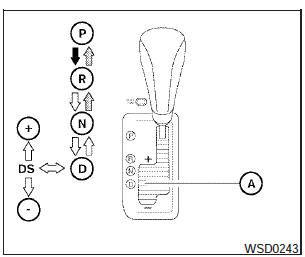
Manual shift mode
When the shift selector is in the Ds (Drive Sport) position, the transmission is ready for the manual shift mode. Shift ranges can be selected manually by moving the shift selector up or down, or pulling the right-side or left-side paddle shifter.
To cancel the Ds mode, return shift selector to the D (Drive) position. The transmission returns to automatic driving mode.
When the shift selector is shifted from D (Drive) to the manual shift gate (A) with the vehicle stopped or while driving, the transmission enters the manual shift mode. Shift ranges can be selected manually. Shift ranges can also be se-
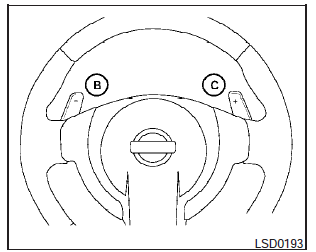
lected using the shift paddles (if so equipped) on the steering wheel (B)- and (C). In the manual shift mode, the shift range is displayed on the position indicator in the meter. When shifting the shift selector to the manual shift gate, the position indicator displays 1 (first) up to 6 (sixth) depending on vehicle speed.
Shift ranges up or down one by one as follows:
1, 2 , 3 , 4 , 5 , 6
M6 (6th):
Use this position for all normal forward driving at highway speeds.
M5 (5th):
Use this position when driving up long slopes, or for engine braking when driving down long slopes.
M4 (4th), M3 (3rd) and M2 (2nd):
Use for hill climbing or engine braking on downhill grades.
M1 (First):
Use this position when climbing steep hills slowly or driving slowly through deep snow, sand or mud, or for maximum engine braking on steep downhill grades.
- Remember not to drive at high speeds for extended periods of time in lower than 6 range. This reduces fuel economy.
When shifting up:
Move the shift selector to the + (up) side. (Shifts to higher range.)
When shifting down:
Move the shift selector to the 2 (down) side.
(Shifts to lower range.) c Moving the shift selector rapidly to the same side twice will shift the ranges in succession.
When canceling the manual shift mode:
Return the shift selector to the D (Drive) position to return the transmission to the normal driving mode.
- In the manual shift mode, the transmission may not shift to the selected gear.
This helps maintain driving performance and reduces the chance of vehicle damage or loss of control.
- In the manual shift mode, the transmission may shift up automatically to a higher range than selected if the engine speed is too high. When the vehicle speed decreases, the transmission automatically shifts down and shifts to 1st gear before the vehicle comes to a stop.
- CVT operation is limited to automatic drive mode when CVT fluid temperature is extremely low even if manual shift mode is selected. This is not a malfunction. When CVT fluid warms up, manual mode can be selected.
- When the CVT fluid temperature is high, the shift range may upshift in lower rpm than usual. This is not a malfunction.
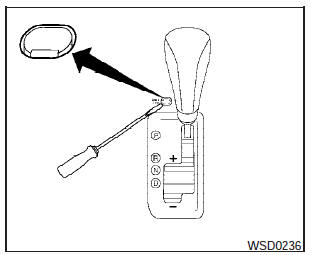
Shift lock release
If the battery charge is low or discharged, the shift selector may not be moved from the P (Park) position even with the brake pedal depressed and the shift selector button pushed.
For models with a steering lock mechanism: If the battery is discharged completely, the steering wheel cannot be locked or unlocked. Do not move the vehicle with the steering wheel locked.
It will be necessary to jump start or have your battery charged, see Jump starting in the In case of emergency section. Contact your NISSAN dealer or a professional towing service.
It will be necessary to jump start or have your battery charged, see Jump starting in the In case of emergency section. Contact your NISSAN dealer or a professional towing service.
To move the shift selector, complete the following procedure:
1. Push the ignition switch to the LOCK position.
2. Apply the parking brake.
3. Remove the shift lock release cover as shown.
4. Insert a small screwdriver in the shift lock release slot and push down.
5. Move the shift selector to the N (Neutral) position while holding down the shift lock release.
6. Push the ignition switch to the ON position to unlock the steering wheel. Now the vehicle may be moved to the desired location.
If the shift selector cannot be moved out of P (Park), have a NISSAN dealer check the transmission as soon as possible.
WARNING:
If the shift selector cannot be moved from the P (Park) position while the engine is running and the brake pedal is depressed, the stop lights may not work. Malfunctioning stop lights could cause an accident injuring yourself and others.
Accelerator downshift in D (Drive) position and manual shift mode
For passing or hill climbing, depress the accelerator pedal to the floor. This shifts the transmission down into lower range, depending on the vehicle speed.
High fluid temperature protection mode
This transmission has a high fluid temperature protection mode. If the fluid temperature becomes too high (for example, when climbing steep grades in high temperature with heavy loads, such as when towing a trailer), engine power and, under some conditions, vehicle speed will be decreased automatically to reduce the chance of transmission damage. Vehicle speed can be controlled with the accelerator pedal, but the engine and vehicle speed may be limited.
Fail-safe
If the vehicle is driven under extreme conditions, such as excessive wheel spinning and subsequent hard braking, the fail-safe system may be activated. The MIL may come on to indicate the fail-safe mode is activated, see Malfunction indicator light (MIL) in the Instrument and controls section.
This will occur even if all electrical circuits are functioning properly. In this case, place the ignition switch in the OFF position and wait for 10 seconds. Then push the switch back to the ON position.
The vehicle should return to its normal operating condition. If it does not return to its normal operating condition, have a NISSAN dealer check the transmission and repair if necessary.
WARNING:
When the high fluid temperature protection mode or fail-safe operation occurs, vehicle speed may be gradually reduced.
The reduced speed may be lower than other traffic, which could increase the chance of a collision. Be especially careful when driving. If necessary, pull to the side of the road at a safe place and allow the transmission to return to normal operation, or have it repaired if necessary.
See also:
Safety
Standard features include dual-stage front airbags, seat-mounted side-impact
airbags and side curtain-type airbags. The seat belts have pretensioners and
load limiters. Active head restraints for ...
Precautions on child restraints
Precautions on child restraints
WARNING:
- Failure to follow the warnings and instructions
for proper use and installation
of child restraints could result in
serious injury or death of a ...
Playing a DVD
Inserting/Ejecting the DVD
The CD/DVD insert slot is located behind the
display screen. To insert the DVD, press the
OPEN/TILT button on the audio unit. The display
screen will automatically mov ...
